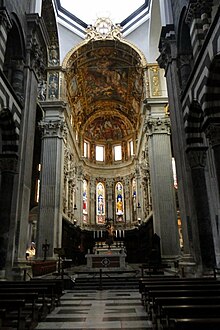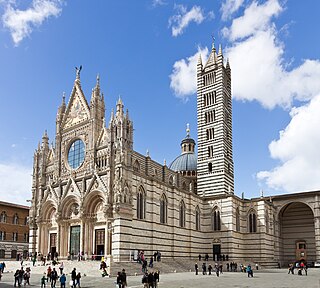
Siena Cathedral is a medieval church in Siena, Italy, dedicated from its earliest days as a Roman Catholic Marian church, and now dedicated to the Assumption of Mary.

Assisi Cathedral, dedicated to San Rufino, is a major church in Assisi, Italy. This stately church in Umbrian Romanesque style was the third church built on the same site to contain the remains of bishop Rufinus of Assisi, martyred in the 3rd century. The construction was started in 1140 to the designs by Giovanni da Gubbio, as attested by the wall inscription visible inside the apse. He may be the same Giovanni who designed the rose-window on the façade of Santa Maria Maggiore in 1163.

Pisa Cathedral is a medieval Roman Catholic cathedral dedicated to the Assumption of the Virgin Mary, in the Piazza dei Miracoli in Pisa, Italy, the oldest of the three structures in the plaza followed by the Pisa Baptistry and the Campanile known as the Leaning Tower of Pisa. The cathedral is a notable example of Romanesque architecture, in particular the style known as Pisan Romanesque. Consecrated in 1118, it is the seat of the Archbishop of Pisa. Construction began in 1063 and was completed in 1092. Additional enlargements and a new facade were built in the 12th century and the roof was replaced after damage from a fire in 1595.

Padua Cathedral, or Basilica Cathedral of Saint Mary of the Assumption, is a Catholic church and minor basilica located on the east end of Piazza Duomo, adjacent to the bishop's palace in Padua, Veneto, Italy.

Fiesole Cathedral, officially the Cathedral of Saint Romulus of Fiesole, is a Roman Catholic cathedral in Fiesole, Tuscany, central Italy. It is the seat of the Bishop of Fiesole and is dedicated to Saint Romulus.

Foligno Cathedral is a Catholic cathedral situated on the Piazza della Repubblica in the center of Foligno, Italy. The cathedral, built on the site of an earlier basilica, is dedicated to the patron saint of the city, the martyr Felician of Foligno, who was buried here in 251 AD. It is the seat of the Bishop of Foligno. It contains the cathedra for the Diocese of Foligno.

Lugano Cathedral is a Roman Catholic cathedral dedicated to Saint Lawrence in Lugano, Ticino, Switzerland. It was founded in the High Middle Ages but rebuilt in the late 15th century, with the façade completed in 1517. It is the seat of the Bishop of Lugano.

Pistoia Cathedral, or Cathedral of Saint Zeno is the main religious building of Pistoia, Tuscany, central Italy, located in the Piazza del Duomo in the centre of the city. It is the seat of the Bishop of Pistoia and is dedicated to Saint Zeno of Verona.

Sarzana Cathedral in Sarzana, Liguria, Italy, is a co-cathedral of the Diocese of La Spezia-Sarzana-Brugnato. It is dedicated to the Assumption of the Virgin Mary. The building is a mixture of the Romanesque and Gothic styles, reflecting the length of the period of its construction, from the early 13th to the late 15th century.

Cagliari Cathedral is a Roman Catholic cathedral in Cagliari, Sardinia, Italy, dedicated to the Virgin Mary and to Saint Cecilia. It is the seat of the archbishop of Cagliari.
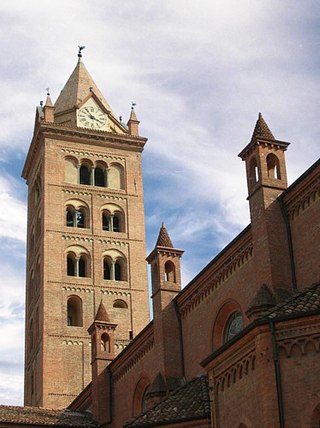
Alba Cathedral is a Roman Catholic cathedral in Alba, province of Cuneo, Piedmont, Italy, dedicated to Saint Lawrence. It is the episcopal seat of the Diocese of Alba.

Ancona Cathedral is a Roman Catholic cathedral in Ancona, central Italy, dedicated to Saint Cyriacus. It is the seat of the Archbishop of Ancona. The building is an example of mixed Romanesque-Byzantine and Gothic elements, and stands on the site of the former acropolis of the Greek city, the Guasco hill which overlooks Ancona and its gulf.
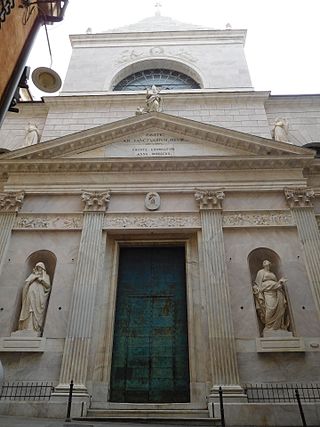
San Siro is a Roman Catholic basilica located on the street of the same name, in the quartiere of the Maddalena in central Genoa, Liguria, Italy.

Tivoli Cathedral is a Roman Catholic cathedral, dedicated to Saint Lawrence, in Tivoli, Lazio, Italy. It is the seat of the bishop of Tivoli.

Trani Cathedral is a Roman Catholic cathedral dedicated to Saint Nicholas the Pilgrim in Trani, Apulia, south-eastern Italy. Formerly the seat of the archbishop of Trani, it is now that of the archbishop of Trani-Barletta-Bisceglie. Consecrated in 1143, is one of the main examples of Apulian Romanesque architecture.

Avellino Cathedral is a Roman Catholic cathedral dedicated to the Assumption of the Virgin Mary and Saint Modestinus in Avellino, Campania, Italy. It is the seat of the bishops of Avellino.
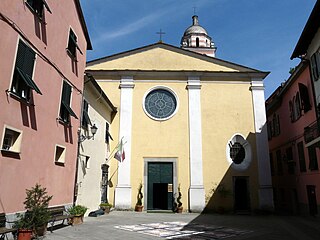
Brugnato Cathedral is a Roman Catholic cathedral located in the old centre of the city of Brugnato, in the Val di Vara in the province of La Spezia, Italy. The dedication is to Saint Peter, Saint Laurence and Saint Columbanus. Once the seat of the bishops of Brugnato, it is now a co-cathedral in the Diocese of La Spezia-Sarzana-Brugnato.

Anagni Cathedral is a Catholic cathedral in Anagni, Lazio, Italy, notable as the summer residence of the Popes for centuries. Home to the cathedra of the Diocese of Anagni-Alatri, it is a Marian church dedicated to the Annunciation of the Blessed Virgin Mary.
The Diocesan museum of Genoa is located in Genova in the region of Liguria. It is found inside the old residence of the canons of the Cathedral of San Lorenzo and is accessible through the cloister of San Lorenzo. The cloister, built in the 12th century, is characterized by two levels of arches resting on double Romanesque columns with leaved capitals. In the 17th century two sides of the building were modified, with the double columns substituted with heavy pilasters in order to support the above two floors constructed for additional space. The museum houses objects from the diocese of Genoa and the surrounding area, including sculptures, paintings, frescoes, illuminated manuscripts, and a series of liturgical items, as well as an archeological area.
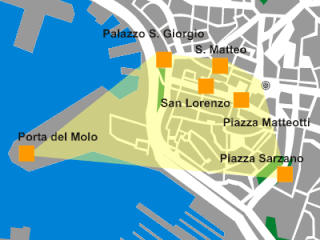
Molo is a neighbourhood in the old town of the Italian city of Genoa. It was one of the six sestieri of ancient Genoa. At present is part of the Genoa's city Municipio I.


